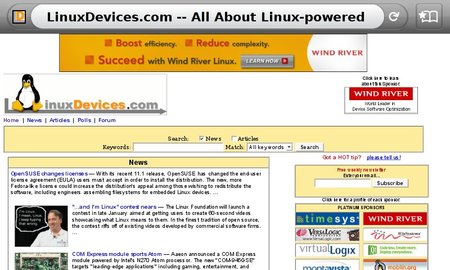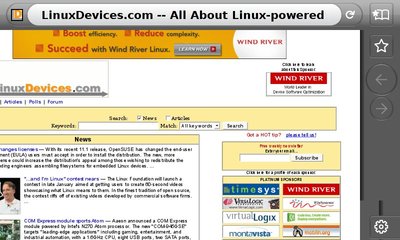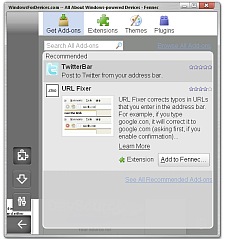Browser for Linux devices hits second alpha
Dec 23, 2008 — by LinuxDevices Staff — from the LinuxDevices Archive — 5 views Mozilla Labs has released the first version of its “Fennec” mobile device browser that can be tested on PC desktops. Available for Linux, Windows, Macintosh, Maemo, and Windows Mobile, the “alpha 2” browser boasts extension hooks, faster panning and zooming, and improved look and feel, the project says.
Mozilla Labs has released the first version of its “Fennec” mobile device browser that can be tested on PC desktops. Available for Linux, Windows, Macintosh, Maemo, and Windows Mobile, the “alpha 2” browser boasts extension hooks, faster panning and zooming, and improved look and feel, the project says.
(Click here for a larger view of Fennec, Alpha 2)
Fennec, which will run via x86 and ARM processors on both Linux-based and Windows Mobile devices, has been under development since last year. It aims to bring a “true web experience” to mobile phones and other non-PC devices, and includes a “bridge” aimed at helping users migrate cookies, bookmarks, history, form-fill data, and other information from their desktop browsers to their mobiles, according to Mozilla Labs.
The project has tinkered openly with Fennec throughout 2008, but has previously released test builds of the web browser only for Nokia's N810 MID (mobile internet device), which runs Linux. As of the new Alpha 2 release, however, test versions are available for Linux, Macintosh, and Windows desktop computers, as well as for the N810 and for Windows Mobile.

Mozilla's Fennec Alpha 2
(Click to enlarge)
The new builds enable authors of both content and extensions to begin experimenting with the software on their desktops, says the project. Touted features in Fennec Alpha 2 include faster panning and zooming, look and feel adjustments, and better responsiveness while pages are loading. Even more significant, the browser is said to include new hooks for authors of third-party extensions, plus an extension manager (below right) similar to the one on desktop editions of Firefox. Claimed to have more than 200 million users, Firefox has become a popular ecosystem for extensions, which can provide tabbed sidebars, content filtering, or automatic synchronization of bookmarks across multiple devices, to cite but a few examples.


Sliding a finger or stylus to the right in Fennec allows accessing the browser's controls (left) and extensions manager (right)
(Click either to enlarge)
Fennec has a simplified user interface, designed to make good use of small screens. For example, sliding a finger or stylus to the left on a device's screen — imitated on the current desktop builds via mouse or trackpad gestures — allows bookmarking a web page, moving to previously viewed web sites, or accessing other browser controls. Sliding to the right provides a tab bar with thumbnails of all currently open tabs, as pictured below.

Fennec's tab navigator
(Click to enlarge)
To obtain Fennec Alpha 2 builds for Linux, Windows, or Macintosh OS X desktop computers, or Nokia's N810, see the Mozilla website, here. Further information about the build is available in a blog entry from developer Mark Finkle, here.
To get instructions on how to create a Windows Mobile version, see the Mozilla site, here.
This article was originally published on LinuxDevices.com and has been donated to the open source community by QuinStreet Inc. Please visit LinuxToday.com for up-to-date news and articles about Linux and open source.